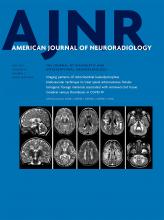It is with great interest that we have read a recently published article by Yahav-Dovrat et al1 investigating the diagnostic performance of a large-vessel occlusion (LVO) detection algorithm on CTA. With a sensitivity of 0.81 for detection of LVO, the authors indicate that the algorithm is suboptimal for use as a diagnostic tool. However, they state that the true potential lies in aiding radiologists in early detection of an LVO and accelerating decision-making. With respect to this statement, some methodologic aspects of their study merit further discussion.
The algorithm that was evaluated used a deep learning–based convolutional neural network to detect occlusions from the ICA terminus to the Sylvian fissure, which included both M1 and M2 segments of the MCA. In their analysis, the definition of LVO only included ICA terminus and M1, but not M2 occlusion. We argue that this definition does not adequately reflect the spectrum of LVOs that need to be targeted by these algorithms, and that M2 occlusion should also have been considered as an LVO. While current guidelines do not provide clear recommendations regarding endovascular treatment in patients with M2 occlusions, accumulating evidence is showing that these patients also benefit from this treatment.2 As a result, in routine clinical practice, endovascular treatment is increasingly being performed in these patients.3 In addition, M2 occlusions occur more commonly than is often thought and they constitute a substantial proportion of the real-world population who have had an acute ischemic stroke due to LVO. Accordingly, in the study of Yahav-Dovrat et al,1 75 patients were identified with an ICA terminus or M1 occlusion, and 44 patients had an occlusion in proximal M2 or distal M2–3 segments. As potential candidates for endovascular treatment, it is crucial that the latter occlusions are also identified quickly and accurately. Yet, it has been demonstrated that M2 occlusions are still frequently missed by radiologists at initial CTA evaluation, whereas the diagnostic error for ICA terminus and M1 occlusions is much lower.4 Furthermore, detection of M2 occlusions by human readers is likely to be more time-consuming because of the smaller caliber, tortuosity, and anatomic variations of these vessels. This indicates a large potential for LVO detection algorithms to accelerate and improve the detection of mainly M2 occlusions and, to a lesser extent, ICA terminus and M1 occlusions.
Regrettably, this is where the current algorithm falls short. In 12 of 44 patients with proximal M2 or distal M2–3 occlusions, the algorithm indicated the presence of LVO. Further subdividing these results reveals a detection rate of 38% (8 of 21) for proximal M2 and 17% (4 of 23) for distal M2–3 occlusions. Considering these cases as non-LVOs and counting them as false-positives, as was done by Yahav-Dovrat et al,1 simply inflates diagnostic performance, and leads to overestimating the potential of the algorithm for early and accurate identification of patients with LVO. Including M2 occlusion in the definition of LVO would have resulted in a considerably lower sensitivity of the algorithm for detection of LVO. However, this would provide a more reliable estimate of diagnostic performance in the population that is targeted for endovascular treatment in routine clinical practice.
Therefore, we strongly urge the need to consider M2 occlusion as LVO when evaluating the diagnostic performance of LVO detection algorithms for a more reliable estimation of their performance and true potential in a clinical setting.
References
- © 2021 by American Journal of Neuroradiology











